MGMT 20135: Critical Review of Racial Inequality & Cognition
VerifiedAdded on 2023/04/12
|8
|1960
|244
Essay
AI Summary
This essay provides a critical analysis and evaluation of an article exploring racial inequality and its influence on critical thinking skills among college students in the US. The review examines the article's background, research objectives, methodology, and findings, particularly focusing on the disparities between African American, Hispanic, Asian, and White students. It considers the role of academic and diversity experiences in shaping critical thinking development. While acknowledging the study's strengths in systematic evaluation and the use of statistical data, the review also points out weaknesses such as limited case data and a lack of qualitative analysis. The essay concludes by emphasizing the significance of addressing racial disparities in education and integrating effective learning strategies within diverse classrooms to foster equal opportunities and enhance critical thinking abilities among all students. Desklib provides access to this and many other solved assignments for students.
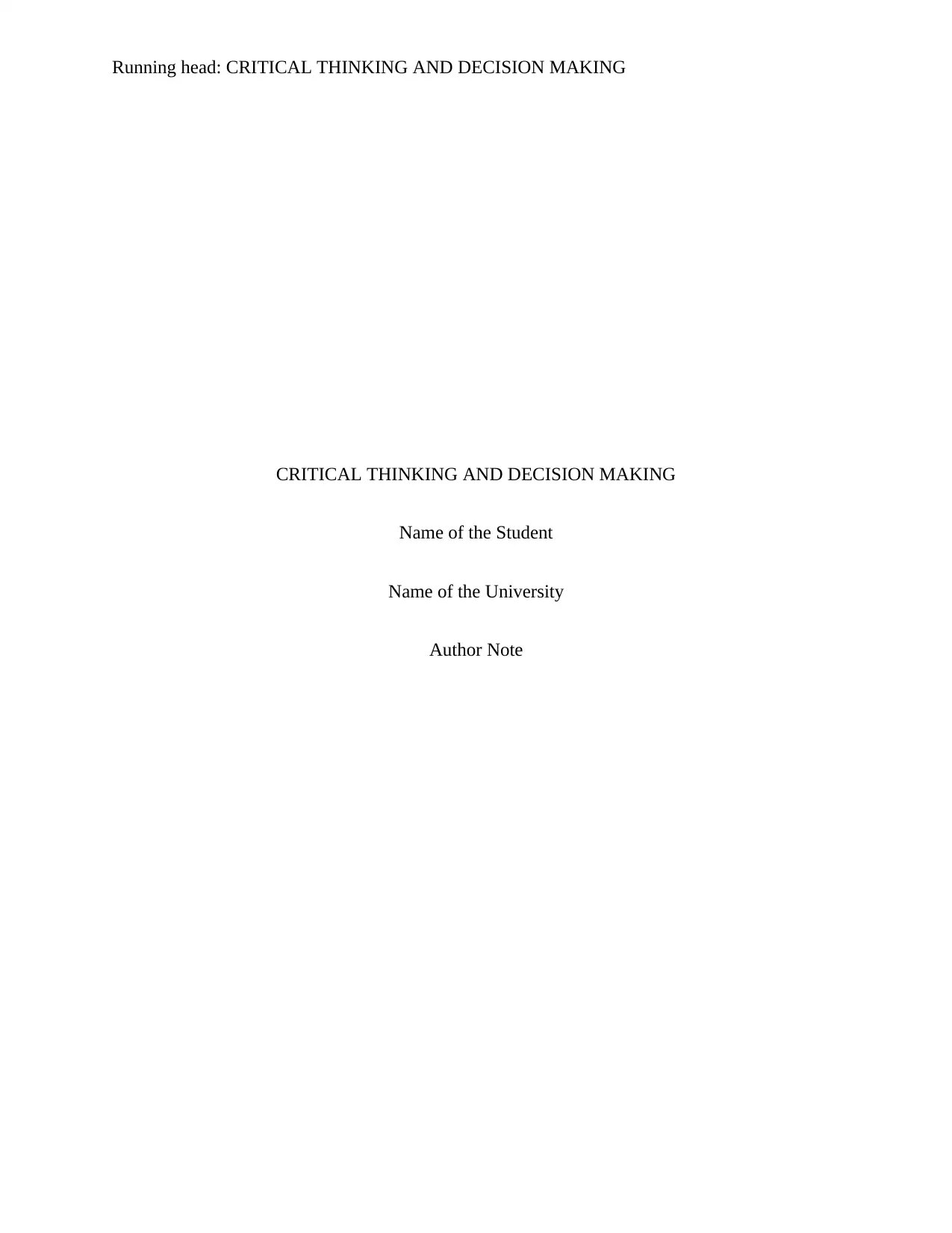
Running head: CRITICAL THINKING AND DECISION MAKING
CRITICAL THINKING AND DECISION MAKING
Name of the Student
Name of the University
Author Note
CRITICAL THINKING AND DECISION MAKING
Name of the Student
Name of the University
Author Note
Secure Best Marks with AI Grader
Need help grading? Try our AI Grader for instant feedback on your assignments.
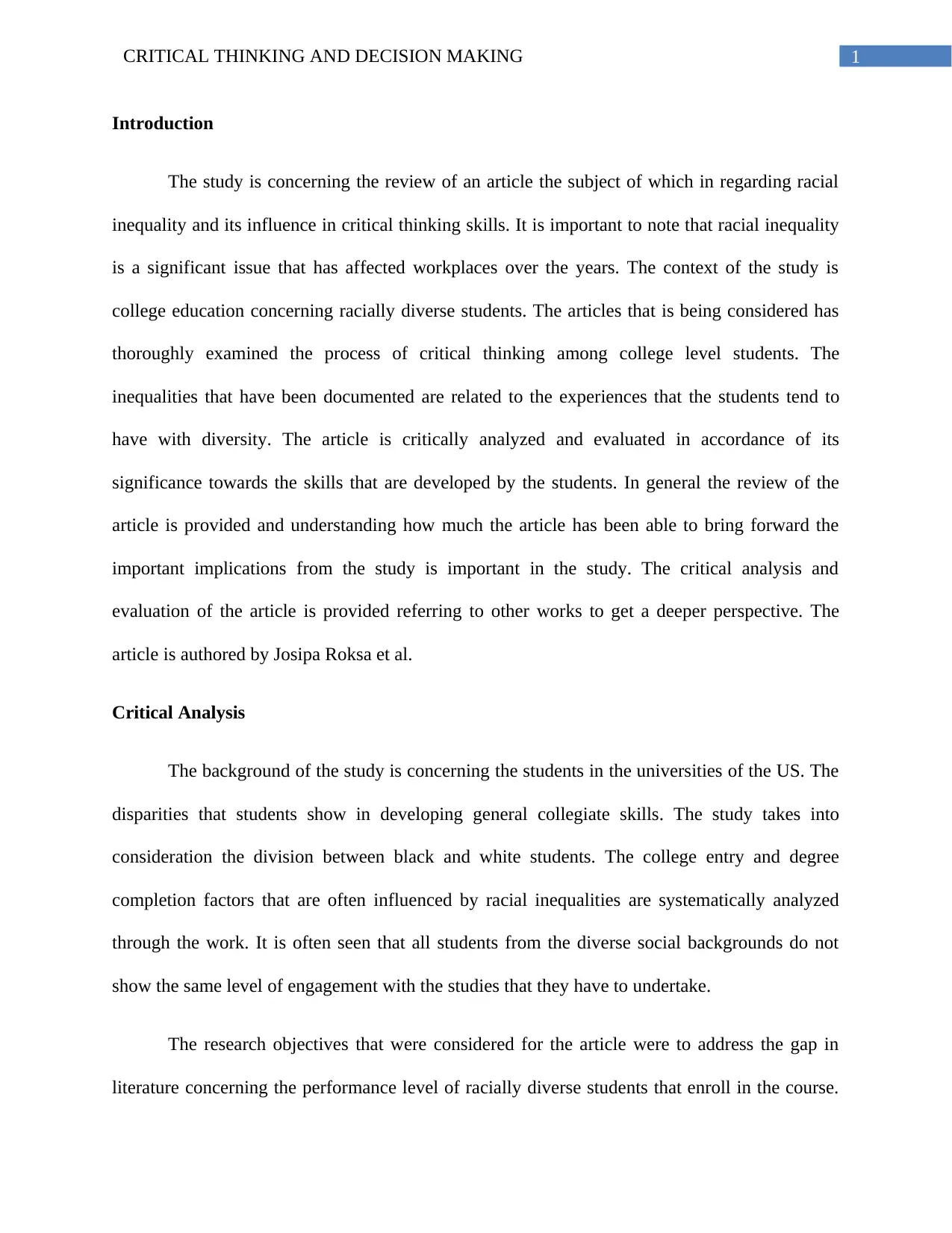
1CRITICAL THINKING AND DECISION MAKING
Introduction
The study is concerning the review of an article the subject of which in regarding racial
inequality and its influence in critical thinking skills. It is important to note that racial inequality
is a significant issue that has affected workplaces over the years. The context of the study is
college education concerning racially diverse students. The articles that is being considered has
thoroughly examined the process of critical thinking among college level students. The
inequalities that have been documented are related to the experiences that the students tend to
have with diversity. The article is critically analyzed and evaluated in accordance of its
significance towards the skills that are developed by the students. In general the review of the
article is provided and understanding how much the article has been able to bring forward the
important implications from the study is important in the study. The critical analysis and
evaluation of the article is provided referring to other works to get a deeper perspective. The
article is authored by Josipa Roksa et al.
Critical Analysis
The background of the study is concerning the students in the universities of the US. The
disparities that students show in developing general collegiate skills. The study takes into
consideration the division between black and white students. The college entry and degree
completion factors that are often influenced by racial inequalities are systematically analyzed
through the work. It is often seen that all students from the diverse social backgrounds do not
show the same level of engagement with the studies that they have to undertake.
The research objectives that were considered for the article were to address the gap in
literature concerning the performance level of racially diverse students that enroll in the course.
Introduction
The study is concerning the review of an article the subject of which in regarding racial
inequality and its influence in critical thinking skills. It is important to note that racial inequality
is a significant issue that has affected workplaces over the years. The context of the study is
college education concerning racially diverse students. The articles that is being considered has
thoroughly examined the process of critical thinking among college level students. The
inequalities that have been documented are related to the experiences that the students tend to
have with diversity. The article is critically analyzed and evaluated in accordance of its
significance towards the skills that are developed by the students. In general the review of the
article is provided and understanding how much the article has been able to bring forward the
important implications from the study is important in the study. The critical analysis and
evaluation of the article is provided referring to other works to get a deeper perspective. The
article is authored by Josipa Roksa et al.
Critical Analysis
The background of the study is concerning the students in the universities of the US. The
disparities that students show in developing general collegiate skills. The study takes into
consideration the division between black and white students. The college entry and degree
completion factors that are often influenced by racial inequalities are systematically analyzed
through the work. It is often seen that all students from the diverse social backgrounds do not
show the same level of engagement with the studies that they have to undertake.
The research objectives that were considered for the article were to address the gap in
literature concerning the performance level of racially diverse students that enroll in the course.
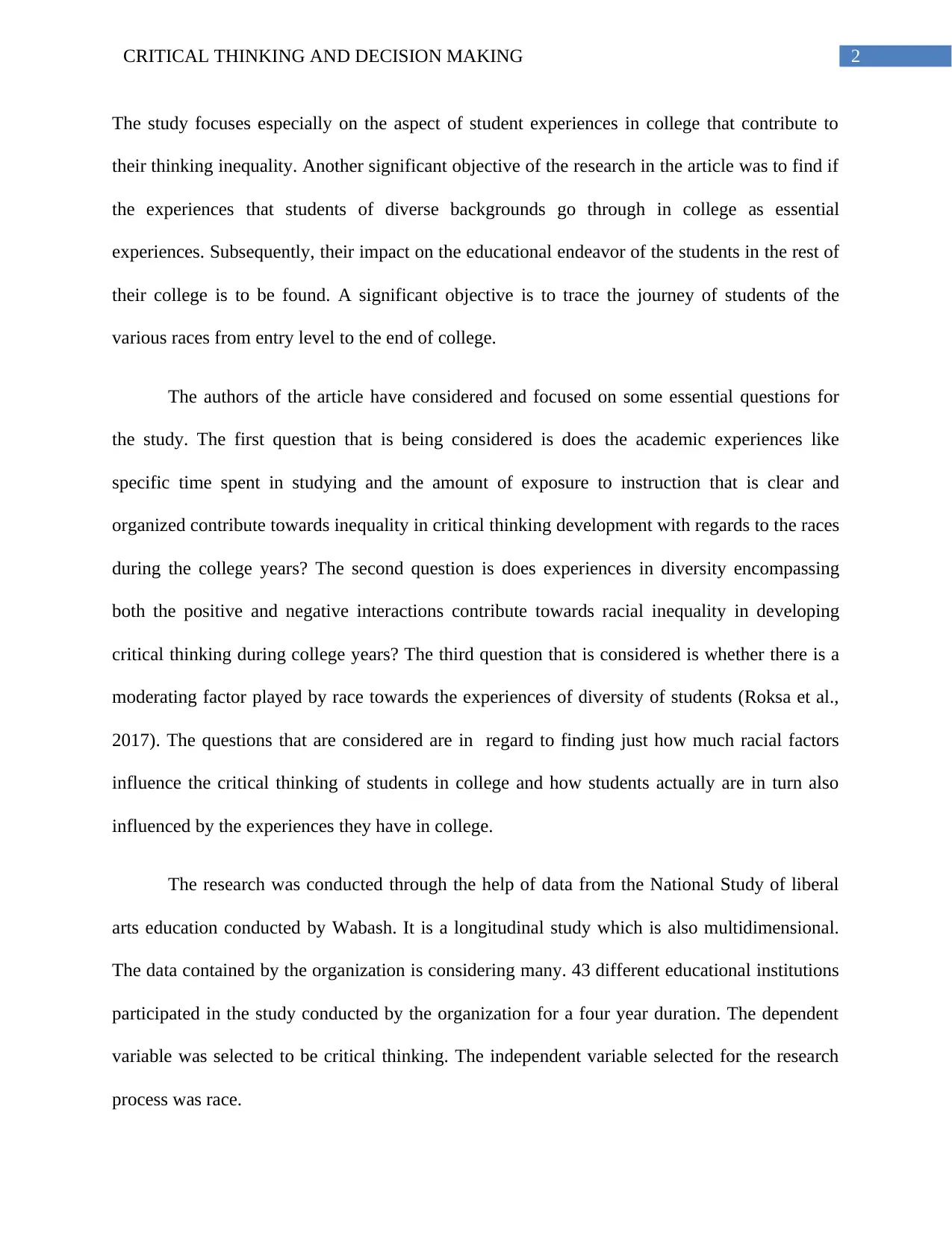
2CRITICAL THINKING AND DECISION MAKING
The study focuses especially on the aspect of student experiences in college that contribute to
their thinking inequality. Another significant objective of the research in the article was to find if
the experiences that students of diverse backgrounds go through in college as essential
experiences. Subsequently, their impact on the educational endeavor of the students in the rest of
their college is to be found. A significant objective is to trace the journey of students of the
various races from entry level to the end of college.
The authors of the article have considered and focused on some essential questions for
the study. The first question that is being considered is does the academic experiences like
specific time spent in studying and the amount of exposure to instruction that is clear and
organized contribute towards inequality in critical thinking development with regards to the races
during the college years? The second question is does experiences in diversity encompassing
both the positive and negative interactions contribute towards racial inequality in developing
critical thinking during college years? The third question that is considered is whether there is a
moderating factor played by race towards the experiences of diversity of students (Roksa et al.,
2017). The questions that are considered are in regard to finding just how much racial factors
influence the critical thinking of students in college and how students actually are in turn also
influenced by the experiences they have in college.
The research was conducted through the help of data from the National Study of liberal
arts education conducted by Wabash. It is a longitudinal study which is also multidimensional.
The data contained by the organization is considering many. 43 different educational institutions
participated in the study conducted by the organization for a four year duration. The dependent
variable was selected to be critical thinking. The independent variable selected for the research
process was race.
The study focuses especially on the aspect of student experiences in college that contribute to
their thinking inequality. Another significant objective of the research in the article was to find if
the experiences that students of diverse backgrounds go through in college as essential
experiences. Subsequently, their impact on the educational endeavor of the students in the rest of
their college is to be found. A significant objective is to trace the journey of students of the
various races from entry level to the end of college.
The authors of the article have considered and focused on some essential questions for
the study. The first question that is being considered is does the academic experiences like
specific time spent in studying and the amount of exposure to instruction that is clear and
organized contribute towards inequality in critical thinking development with regards to the races
during the college years? The second question is does experiences in diversity encompassing
both the positive and negative interactions contribute towards racial inequality in developing
critical thinking during college years? The third question that is considered is whether there is a
moderating factor played by race towards the experiences of diversity of students (Roksa et al.,
2017). The questions that are considered are in regard to finding just how much racial factors
influence the critical thinking of students in college and how students actually are in turn also
influenced by the experiences they have in college.
The research was conducted through the help of data from the National Study of liberal
arts education conducted by Wabash. It is a longitudinal study which is also multidimensional.
The data contained by the organization is considering many. 43 different educational institutions
participated in the study conducted by the organization for a four year duration. The dependent
variable was selected to be critical thinking. The independent variable selected for the research
process was race.
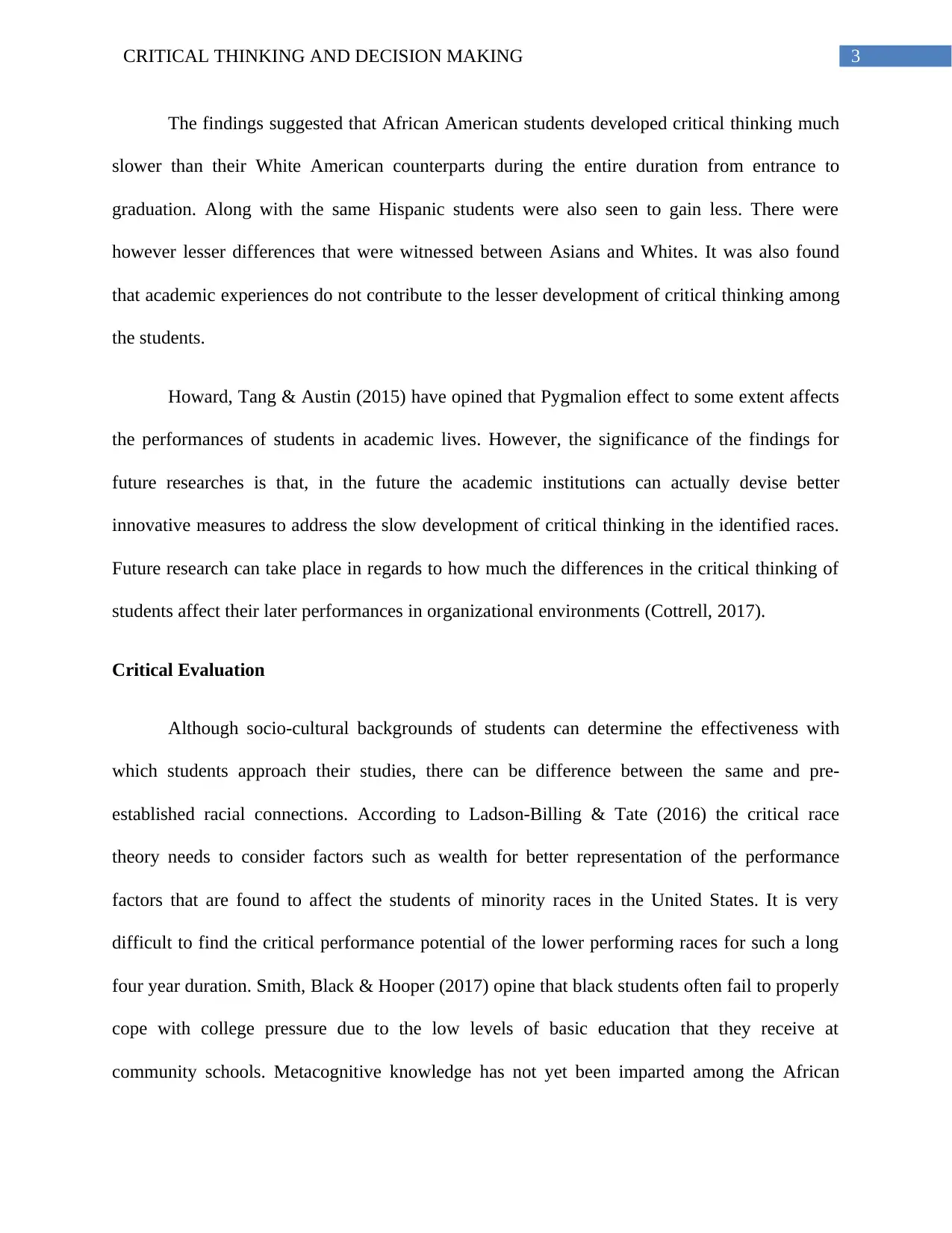
3CRITICAL THINKING AND DECISION MAKING
The findings suggested that African American students developed critical thinking much
slower than their White American counterparts during the entire duration from entrance to
graduation. Along with the same Hispanic students were also seen to gain less. There were
however lesser differences that were witnessed between Asians and Whites. It was also found
that academic experiences do not contribute to the lesser development of critical thinking among
the students.
Howard, Tang & Austin (2015) have opined that Pygmalion effect to some extent affects
the performances of students in academic lives. However, the significance of the findings for
future researches is that, in the future the academic institutions can actually devise better
innovative measures to address the slow development of critical thinking in the identified races.
Future research can take place in regards to how much the differences in the critical thinking of
students affect their later performances in organizational environments (Cottrell, 2017).
Critical Evaluation
Although socio-cultural backgrounds of students can determine the effectiveness with
which students approach their studies, there can be difference between the same and pre-
established racial connections. According to Ladson-Billing & Tate (2016) the critical race
theory needs to consider factors such as wealth for better representation of the performance
factors that are found to affect the students of minority races in the United States. It is very
difficult to find the critical performance potential of the lower performing races for such a long
four year duration. Smith, Black & Hooper (2017) opine that black students often fail to properly
cope with college pressure due to the low levels of basic education that they receive at
community schools. Metacognitive knowledge has not yet been imparted among the African
The findings suggested that African American students developed critical thinking much
slower than their White American counterparts during the entire duration from entrance to
graduation. Along with the same Hispanic students were also seen to gain less. There were
however lesser differences that were witnessed between Asians and Whites. It was also found
that academic experiences do not contribute to the lesser development of critical thinking among
the students.
Howard, Tang & Austin (2015) have opined that Pygmalion effect to some extent affects
the performances of students in academic lives. However, the significance of the findings for
future researches is that, in the future the academic institutions can actually devise better
innovative measures to address the slow development of critical thinking in the identified races.
Future research can take place in regards to how much the differences in the critical thinking of
students affect their later performances in organizational environments (Cottrell, 2017).
Critical Evaluation
Although socio-cultural backgrounds of students can determine the effectiveness with
which students approach their studies, there can be difference between the same and pre-
established racial connections. According to Ladson-Billing & Tate (2016) the critical race
theory needs to consider factors such as wealth for better representation of the performance
factors that are found to affect the students of minority races in the United States. It is very
difficult to find the critical performance potential of the lower performing races for such a long
four year duration. Smith, Black & Hooper (2017) opine that black students often fail to properly
cope with college pressure due to the low levels of basic education that they receive at
community schools. Metacognitive knowledge has not yet been imparted among the African
Secure Best Marks with AI Grader
Need help grading? Try our AI Grader for instant feedback on your assignments.
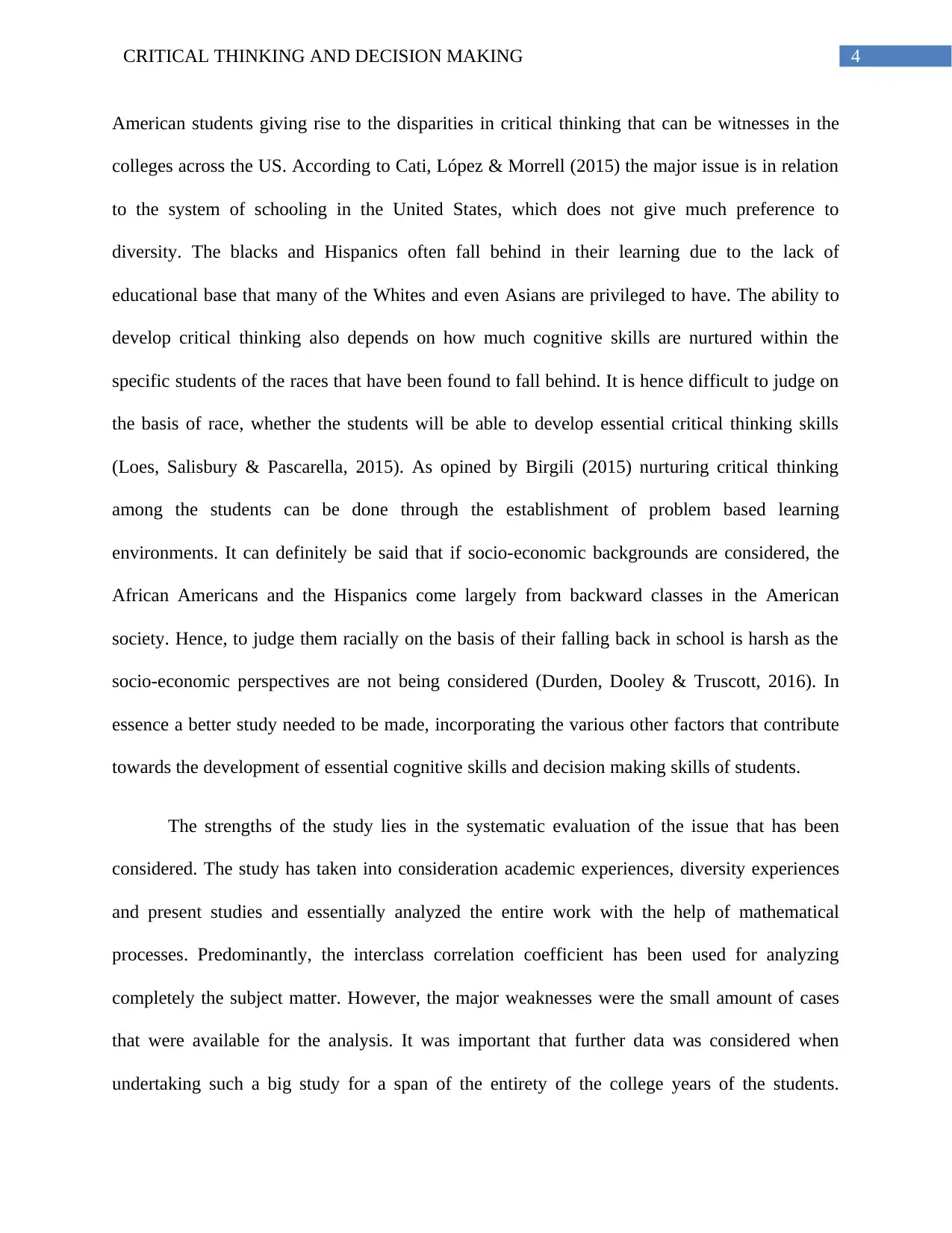
4CRITICAL THINKING AND DECISION MAKING
American students giving rise to the disparities in critical thinking that can be witnesses in the
colleges across the US. According to Cati, López & Morrell (2015) the major issue is in relation
to the system of schooling in the United States, which does not give much preference to
diversity. The blacks and Hispanics often fall behind in their learning due to the lack of
educational base that many of the Whites and even Asians are privileged to have. The ability to
develop critical thinking also depends on how much cognitive skills are nurtured within the
specific students of the races that have been found to fall behind. It is hence difficult to judge on
the basis of race, whether the students will be able to develop essential critical thinking skills
(Loes, Salisbury & Pascarella, 2015). As opined by Birgili (2015) nurturing critical thinking
among the students can be done through the establishment of problem based learning
environments. It can definitely be said that if socio-economic backgrounds are considered, the
African Americans and the Hispanics come largely from backward classes in the American
society. Hence, to judge them racially on the basis of their falling back in school is harsh as the
socio-economic perspectives are not being considered (Durden, Dooley & Truscott, 2016). In
essence a better study needed to be made, incorporating the various other factors that contribute
towards the development of essential cognitive skills and decision making skills of students.
The strengths of the study lies in the systematic evaluation of the issue that has been
considered. The study has taken into consideration academic experiences, diversity experiences
and present studies and essentially analyzed the entire work with the help of mathematical
processes. Predominantly, the interclass correlation coefficient has been used for analyzing
completely the subject matter. However, the major weaknesses were the small amount of cases
that were available for the analysis. It was important that further data was considered when
undertaking such a big study for a span of the entirety of the college years of the students.
American students giving rise to the disparities in critical thinking that can be witnesses in the
colleges across the US. According to Cati, López & Morrell (2015) the major issue is in relation
to the system of schooling in the United States, which does not give much preference to
diversity. The blacks and Hispanics often fall behind in their learning due to the lack of
educational base that many of the Whites and even Asians are privileged to have. The ability to
develop critical thinking also depends on how much cognitive skills are nurtured within the
specific students of the races that have been found to fall behind. It is hence difficult to judge on
the basis of race, whether the students will be able to develop essential critical thinking skills
(Loes, Salisbury & Pascarella, 2015). As opined by Birgili (2015) nurturing critical thinking
among the students can be done through the establishment of problem based learning
environments. It can definitely be said that if socio-economic backgrounds are considered, the
African Americans and the Hispanics come largely from backward classes in the American
society. Hence, to judge them racially on the basis of their falling back in school is harsh as the
socio-economic perspectives are not being considered (Durden, Dooley & Truscott, 2016). In
essence a better study needed to be made, incorporating the various other factors that contribute
towards the development of essential cognitive skills and decision making skills of students.
The strengths of the study lies in the systematic evaluation of the issue that has been
considered. The study has taken into consideration academic experiences, diversity experiences
and present studies and essentially analyzed the entire work with the help of mathematical
processes. Predominantly, the interclass correlation coefficient has been used for analyzing
completely the subject matter. However, the major weaknesses were the small amount of cases
that were available for the analysis. It was important that further data was considered when
undertaking such a big study for a span of the entirety of the college years of the students.
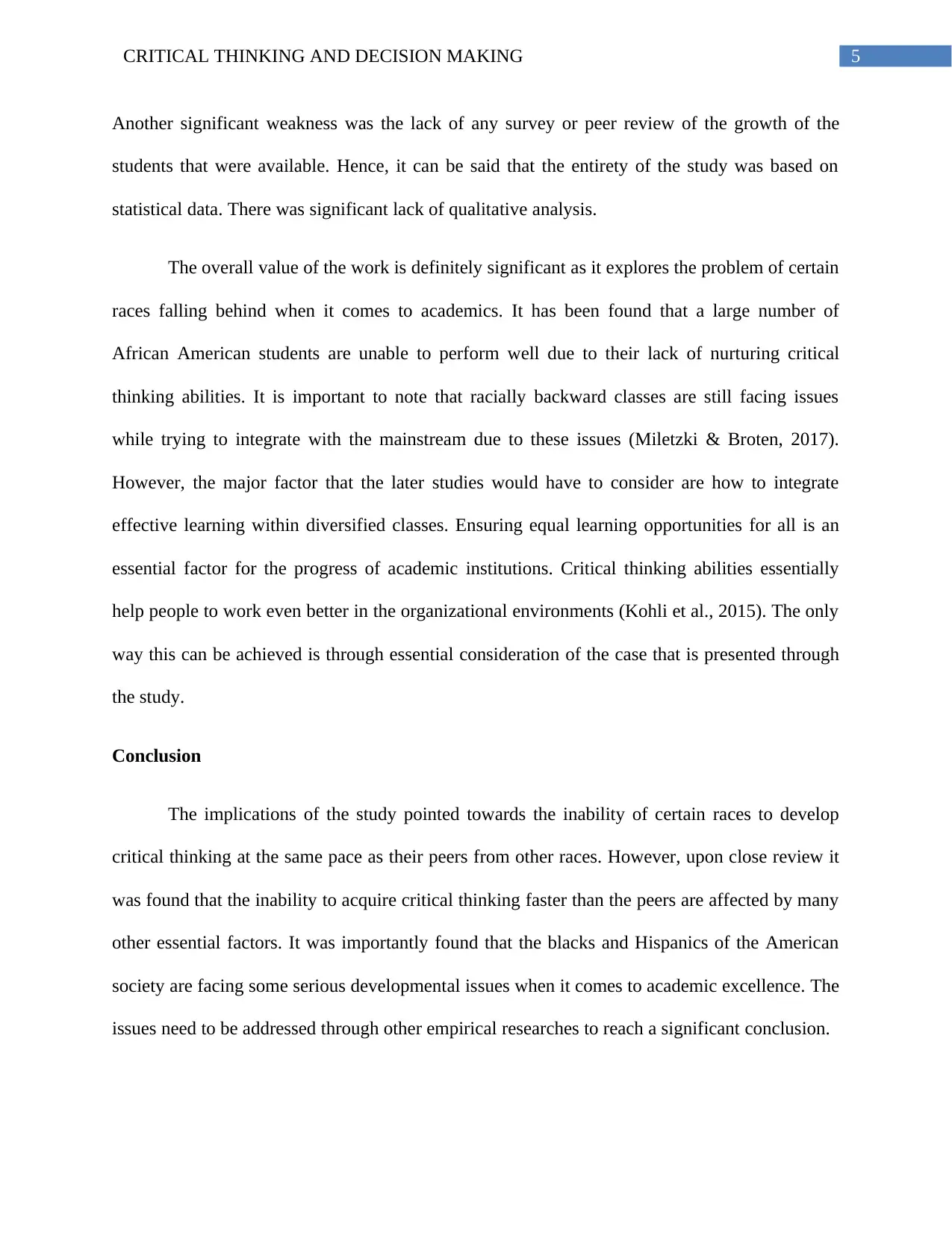
5CRITICAL THINKING AND DECISION MAKING
Another significant weakness was the lack of any survey or peer review of the growth of the
students that were available. Hence, it can be said that the entirety of the study was based on
statistical data. There was significant lack of qualitative analysis.
The overall value of the work is definitely significant as it explores the problem of certain
races falling behind when it comes to academics. It has been found that a large number of
African American students are unable to perform well due to their lack of nurturing critical
thinking abilities. It is important to note that racially backward classes are still facing issues
while trying to integrate with the mainstream due to these issues (Miletzki & Broten, 2017).
However, the major factor that the later studies would have to consider are how to integrate
effective learning within diversified classes. Ensuring equal learning opportunities for all is an
essential factor for the progress of academic institutions. Critical thinking abilities essentially
help people to work even better in the organizational environments (Kohli et al., 2015). The only
way this can be achieved is through essential consideration of the case that is presented through
the study.
Conclusion
The implications of the study pointed towards the inability of certain races to develop
critical thinking at the same pace as their peers from other races. However, upon close review it
was found that the inability to acquire critical thinking faster than the peers are affected by many
other essential factors. It was importantly found that the blacks and Hispanics of the American
society are facing some serious developmental issues when it comes to academic excellence. The
issues need to be addressed through other empirical researches to reach a significant conclusion.
Another significant weakness was the lack of any survey or peer review of the growth of the
students that were available. Hence, it can be said that the entirety of the study was based on
statistical data. There was significant lack of qualitative analysis.
The overall value of the work is definitely significant as it explores the problem of certain
races falling behind when it comes to academics. It has been found that a large number of
African American students are unable to perform well due to their lack of nurturing critical
thinking abilities. It is important to note that racially backward classes are still facing issues
while trying to integrate with the mainstream due to these issues (Miletzki & Broten, 2017).
However, the major factor that the later studies would have to consider are how to integrate
effective learning within diversified classes. Ensuring equal learning opportunities for all is an
essential factor for the progress of academic institutions. Critical thinking abilities essentially
help people to work even better in the organizational environments (Kohli et al., 2015). The only
way this can be achieved is through essential consideration of the case that is presented through
the study.
Conclusion
The implications of the study pointed towards the inability of certain races to develop
critical thinking at the same pace as their peers from other races. However, upon close review it
was found that the inability to acquire critical thinking faster than the peers are affected by many
other essential factors. It was importantly found that the blacks and Hispanics of the American
society are facing some serious developmental issues when it comes to academic excellence. The
issues need to be addressed through other empirical researches to reach a significant conclusion.
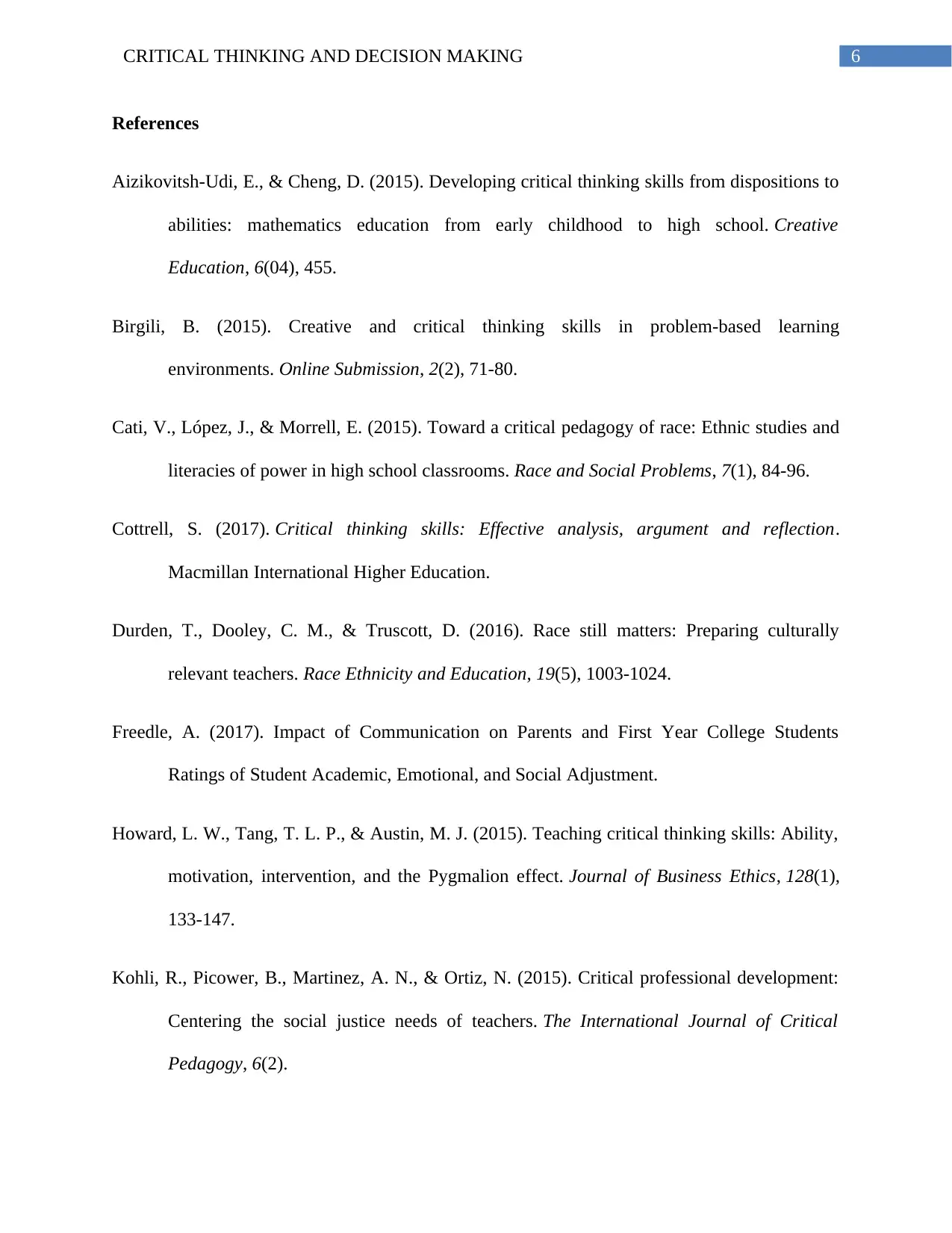
6CRITICAL THINKING AND DECISION MAKING
References
Aizikovitsh-Udi, E., & Cheng, D. (2015). Developing critical thinking skills from dispositions to
abilities: mathematics education from early childhood to high school. Creative
Education, 6(04), 455.
Birgili, B. (2015). Creative and critical thinking skills in problem-based learning
environments. Online Submission, 2(2), 71-80.
Cati, V., López, J., & Morrell, E. (2015). Toward a critical pedagogy of race: Ethnic studies and
literacies of power in high school classrooms. Race and Social Problems, 7(1), 84-96.
Cottrell, S. (2017). Critical thinking skills: Effective analysis, argument and reflection.
Macmillan International Higher Education.
Durden, T., Dooley, C. M., & Truscott, D. (2016). Race still matters: Preparing culturally
relevant teachers. Race Ethnicity and Education, 19(5), 1003-1024.
Freedle, A. (2017). Impact of Communication on Parents and First Year College Students
Ratings of Student Academic, Emotional, and Social Adjustment.
Howard, L. W., Tang, T. L. P., & Austin, M. J. (2015). Teaching critical thinking skills: Ability,
motivation, intervention, and the Pygmalion effect. Journal of Business Ethics, 128(1),
133-147.
Kohli, R., Picower, B., Martinez, A. N., & Ortiz, N. (2015). Critical professional development:
Centering the social justice needs of teachers. The International Journal of Critical
Pedagogy, 6(2).
References
Aizikovitsh-Udi, E., & Cheng, D. (2015). Developing critical thinking skills from dispositions to
abilities: mathematics education from early childhood to high school. Creative
Education, 6(04), 455.
Birgili, B. (2015). Creative and critical thinking skills in problem-based learning
environments. Online Submission, 2(2), 71-80.
Cati, V., López, J., & Morrell, E. (2015). Toward a critical pedagogy of race: Ethnic studies and
literacies of power in high school classrooms. Race and Social Problems, 7(1), 84-96.
Cottrell, S. (2017). Critical thinking skills: Effective analysis, argument and reflection.
Macmillan International Higher Education.
Durden, T., Dooley, C. M., & Truscott, D. (2016). Race still matters: Preparing culturally
relevant teachers. Race Ethnicity and Education, 19(5), 1003-1024.
Freedle, A. (2017). Impact of Communication on Parents and First Year College Students
Ratings of Student Academic, Emotional, and Social Adjustment.
Howard, L. W., Tang, T. L. P., & Austin, M. J. (2015). Teaching critical thinking skills: Ability,
motivation, intervention, and the Pygmalion effect. Journal of Business Ethics, 128(1),
133-147.
Kohli, R., Picower, B., Martinez, A. N., & Ortiz, N. (2015). Critical professional development:
Centering the social justice needs of teachers. The International Journal of Critical
Pedagogy, 6(2).
Paraphrase This Document
Need a fresh take? Get an instant paraphrase of this document with our AI Paraphraser
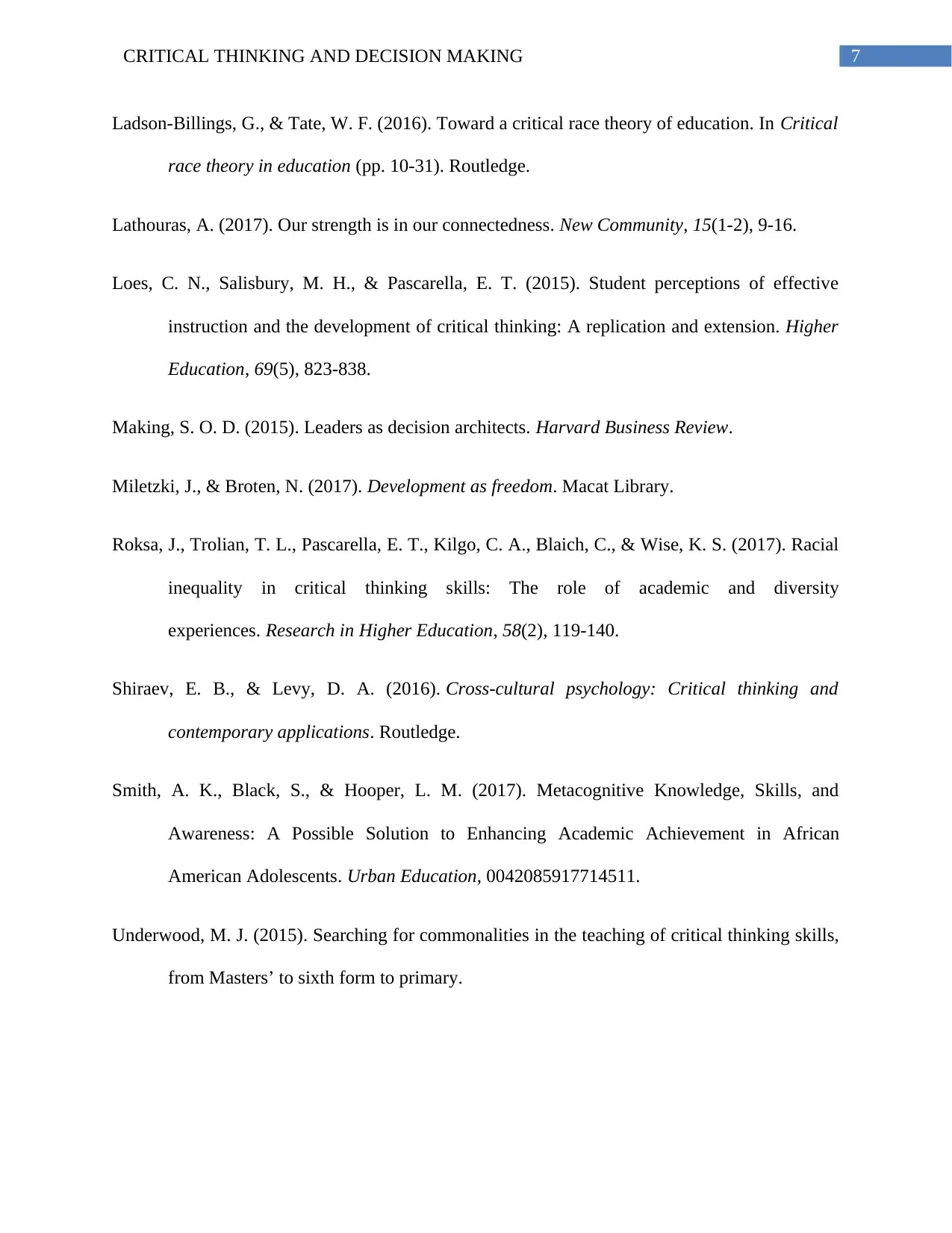
7CRITICAL THINKING AND DECISION MAKING
Ladson-Billings, G., & Tate, W. F. (2016). Toward a critical race theory of education. In Critical
race theory in education (pp. 10-31). Routledge.
Lathouras, A. (2017). Our strength is in our connectedness. New Community, 15(1-2), 9-16.
Loes, C. N., Salisbury, M. H., & Pascarella, E. T. (2015). Student perceptions of effective
instruction and the development of critical thinking: A replication and extension. Higher
Education, 69(5), 823-838.
Making, S. O. D. (2015). Leaders as decision architects. Harvard Business Review.
Miletzki, J., & Broten, N. (2017). Development as freedom. Macat Library.
Roksa, J., Trolian, T. L., Pascarella, E. T., Kilgo, C. A., Blaich, C., & Wise, K. S. (2017). Racial
inequality in critical thinking skills: The role of academic and diversity
experiences. Research in Higher Education, 58(2), 119-140.
Shiraev, E. B., & Levy, D. A. (2016). Cross-cultural psychology: Critical thinking and
contemporary applications. Routledge.
Smith, A. K., Black, S., & Hooper, L. M. (2017). Metacognitive Knowledge, Skills, and
Awareness: A Possible Solution to Enhancing Academic Achievement in African
American Adolescents. Urban Education, 0042085917714511.
Underwood, M. J. (2015). Searching for commonalities in the teaching of critical thinking skills,
from Masters’ to sixth form to primary.
Ladson-Billings, G., & Tate, W. F. (2016). Toward a critical race theory of education. In Critical
race theory in education (pp. 10-31). Routledge.
Lathouras, A. (2017). Our strength is in our connectedness. New Community, 15(1-2), 9-16.
Loes, C. N., Salisbury, M. H., & Pascarella, E. T. (2015). Student perceptions of effective
instruction and the development of critical thinking: A replication and extension. Higher
Education, 69(5), 823-838.
Making, S. O. D. (2015). Leaders as decision architects. Harvard Business Review.
Miletzki, J., & Broten, N. (2017). Development as freedom. Macat Library.
Roksa, J., Trolian, T. L., Pascarella, E. T., Kilgo, C. A., Blaich, C., & Wise, K. S. (2017). Racial
inequality in critical thinking skills: The role of academic and diversity
experiences. Research in Higher Education, 58(2), 119-140.
Shiraev, E. B., & Levy, D. A. (2016). Cross-cultural psychology: Critical thinking and
contemporary applications. Routledge.
Smith, A. K., Black, S., & Hooper, L. M. (2017). Metacognitive Knowledge, Skills, and
Awareness: A Possible Solution to Enhancing Academic Achievement in African
American Adolescents. Urban Education, 0042085917714511.
Underwood, M. J. (2015). Searching for commonalities in the teaching of critical thinking skills,
from Masters’ to sixth form to primary.
1 out of 8
Related Documents
Your All-in-One AI-Powered Toolkit for Academic Success.
+13062052269
info@desklib.com
Available 24*7 on WhatsApp / Email
![[object Object]](/_next/static/media/star-bottom.7253800d.svg)
Unlock your academic potential
© 2024 | Zucol Services PVT LTD | All rights reserved.




